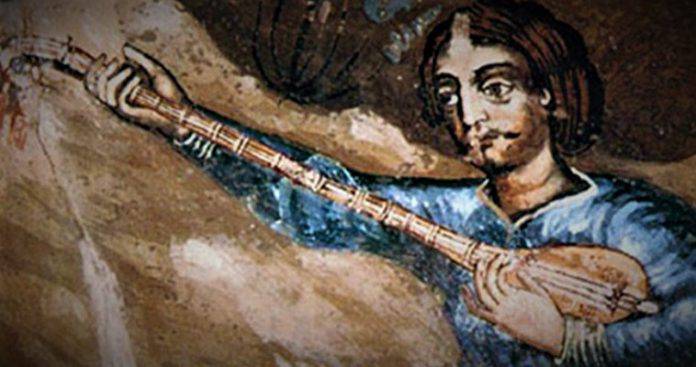Giorgos Moustairas: The bouzouki in love, in joy, and in sorrow, through Greek folk tradition
21/11/2020
The bouzouki, an instrument endowed with the ability to express in its entirety, extreme emotional states (love, joy, sorrow) has been registered, with its various occasional names, in folk songs and folk tales:
“The lad knew and made the tambouras sing well. He made it sing at night and a princess also heard him. In the morning the beauty of the land told the old woman:
– Old woman, who did you have here in your house and he plucked the tambouras so well?
“A stranger came, my princess,” said the old woman, and he plucked it.
“Tell him to come to meet him,” said the princess.
The lad went to the princess and she asked him where he waas from, that she really liked the tambouras and wanted to wed him.
…………………………………
And when the princess had not heard the tambouras she shouted to him:
– Why don’t you play the tambouras tonight, why are you just pensive?
And the lad confessed what the King had said to him.
– And that’s why you are sore? the princess told him. Sing the tambouras quickly so we can feast a little and tomorrow morning come by here.
The lad played the tambouras all night and they had a great time“.
(“The Dymarika”).
In the Cypriot song of the Akritic circle “The abduction of Levantis’s daughter by Digenis” there is a reference to Akritas’ skill: “... the tambourine sang the sweetness of the world …”, thanks to which, while he was invited to a wedding, he enchanted the bride with his playing and… took her with him. This particular instrument is a great seducer, as is confirmed in the following songs:
“This summer,
I was chasing a bird,
I was chasing, trying,
But I could not catch it.
Playing my tambouras,
It came and sat next to me. “
“At dawn I want to get up
to enter an orchard
to pick an apple from the tree
to pick a quince of love
to cut an olive leaf
to play the liogari.
To go to my love
to wake her up:
– Liogari I do not play heavily.
why don’t you sound full?
– Strong strings place on me
and strike between the frets.
And if I don’t make your blonde come out
break me down in three pieces “.
“I never loved a girl for money,
rather than with my songs and the tambouras “.
“My very woeful tambouras why do you not sound fully?
– Tighten the strings well and strike me soundly
and if I don’t bring you the blonde, break me in three pieces “.
“A Dervish was passing through the bazaar
playing the yogari and singing.
And Kanto stared at him from the window.
– Pass, Dervish, keep passing, pass and pass again
and on good return pass and come upstairs.
– Why don’t you take your spindle and me my tambouras
and let’s go to my room and have a merry time“.
In variation with the above verses, the following have also been recorded:
“My sweet sounding bouzouki, sweetheart, why don’t you sound fully?”
“A dervish was strolling in the midst of the bazaar,
playing the bouzouki, playing the tambouras “
Do not bang the instruments
Earlier we saw elements of anthropomorphism, where the tambouras is called “woeful“. The same characterization is used in other folksongs (without the emphasis of the prefix “very“): “Play you woeful tambouras and you too karantouzeni” or “Sing woeful tambouras, speak as well bouzouki” We find a similar characterization in the verse: “Do not bang the instruments, the pitiful bouzoukis”
This shows on the one hand the communication of the organ player with the instrument, which results in an informal anthropomorphic treatment and at the same time the high emotional charge that this stringed instrument achieves, a charge that is demonstrated by the characterizations: “woeful, pitiful“. This becomes clear in the following song: “And bring me the tambouras, that sad toy“.
Characteristic again is the name of the instrument with the word sevdas (Turkish for longing). (From a description in the prison of Nafplion):
“Another painting on the opposite wall depicted a large tree, with many branches and broad-leaved, shaken by a gust of strong wind, and at its root lay a man wearing a foustanella (Greek kilt) with a proudly twisted mustache, with the dog at his feet and the yogari in his arms, playing and singing.
In front of him was written, for us, what he was singing: I have sevdas, I hold sevdas, and full of sevdas am I, and as I find the weather so I do sail“(A. Karkavitsas, “To Vouleftiko” (Parliamentary)“, 1892).
Note here that in addition to the names “tambouras” and “bouzouki” there were also: “karantouzeni”, “yogari” – “liogari” and “sevdas”, as we saw in the above reports but also “bulgari” (as it is called in Crete) .
The many references to the instrument – the more you search, the more you find – are impressive, by whatever name, that we find in folk songs but also in old literary texts. Indicatively, from a rough sample:
“One strikes the tambouras and the other the bouzouki”
“They have bouzouki and violins, they sing all day”
“… he holds in his hands a silver tambouras …”
– «… He moved along the sides, with the tambouras singing: I am not born a rayah, I do not bow to Turks … “
“One accompanies their dance with a soft song
and with a sweet-sweet lullaby of his tambouras … ” (Kostas Krystallis “Picking the grapes/Vintage”).
“Michos brought the bouzouki, Mitros crossed one leg on the other and struck a syrtos (Greek folk dance)…” (Nikos Spandonis “Our Athens”, 1893).
“… the tambouras should play, so that Emine Hanoum should not be troubled” (Nikos Kazantzakis “Captain Michalis”)
Concluding this brief tour of the bouzouki, its ancestors and variations, the course of history, songs, folk tales and literature, I quote an excerpt from an old fairy tale, where reference is made to the bouzouki:
“He goes near this house and sees his sister the strix (mythological man-eating monster) sitting inside. As soon as the strix saw Giannakis, she ran to greet him:
– Welcome. Come in Giannaki.
She led Giannakis into the house.
– Sit down, Giannaki, let me go to the kitchen to make you coffee. Giannakis sat down. She also gave him a bouzouki to play so that she would know that Giannakis was there. He went out of the room. She made as if she was going to make him coffee and she went to the basement to grind her teeth to eat Giannakis. Giannakis played the bouzouki. At that moment, a mouse appeared and said to Giannakis:
– Give me the bouzouki and I’ll play it with my tail and Giannakis, get up and leave because your sister is gnashing her teeth to eat you.
At that time, Giannakis was scared and left the bouzouki to the mouse and got up and left“.
(“The Strix”).











